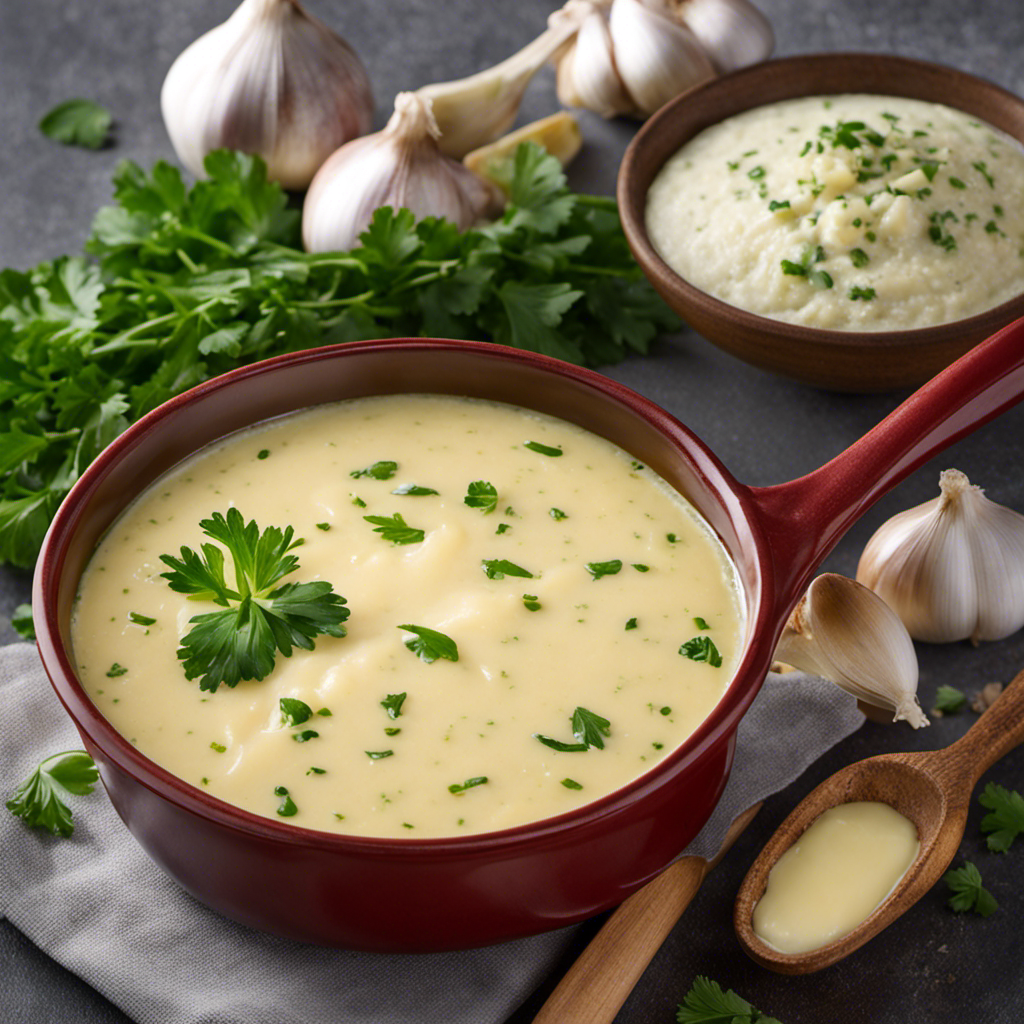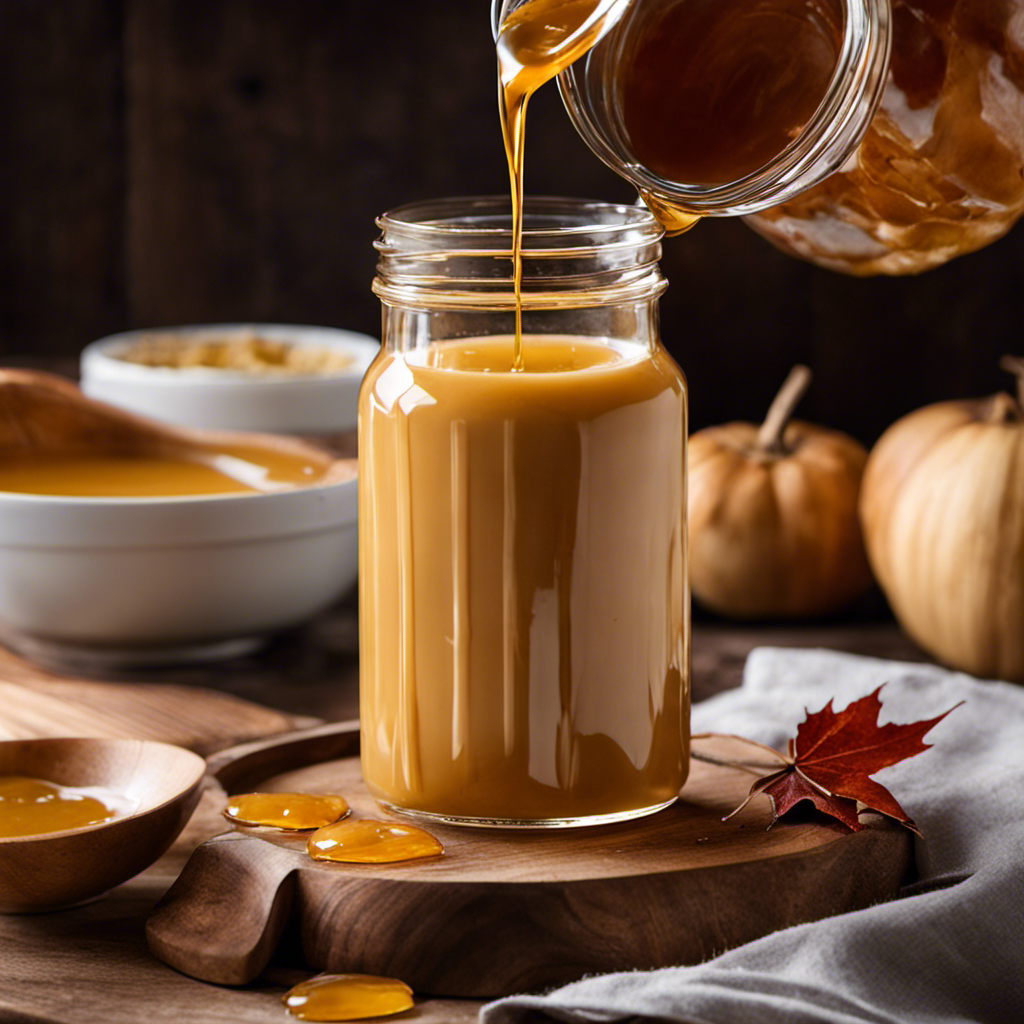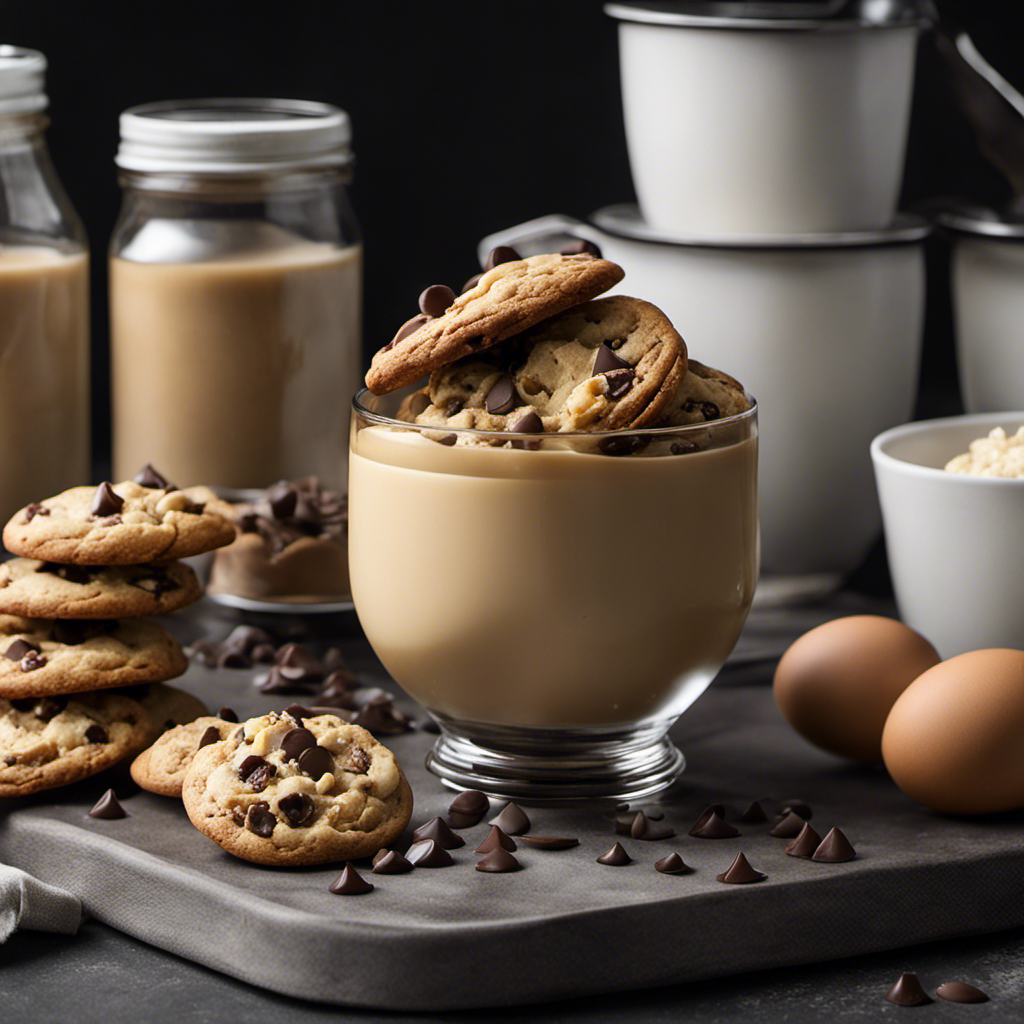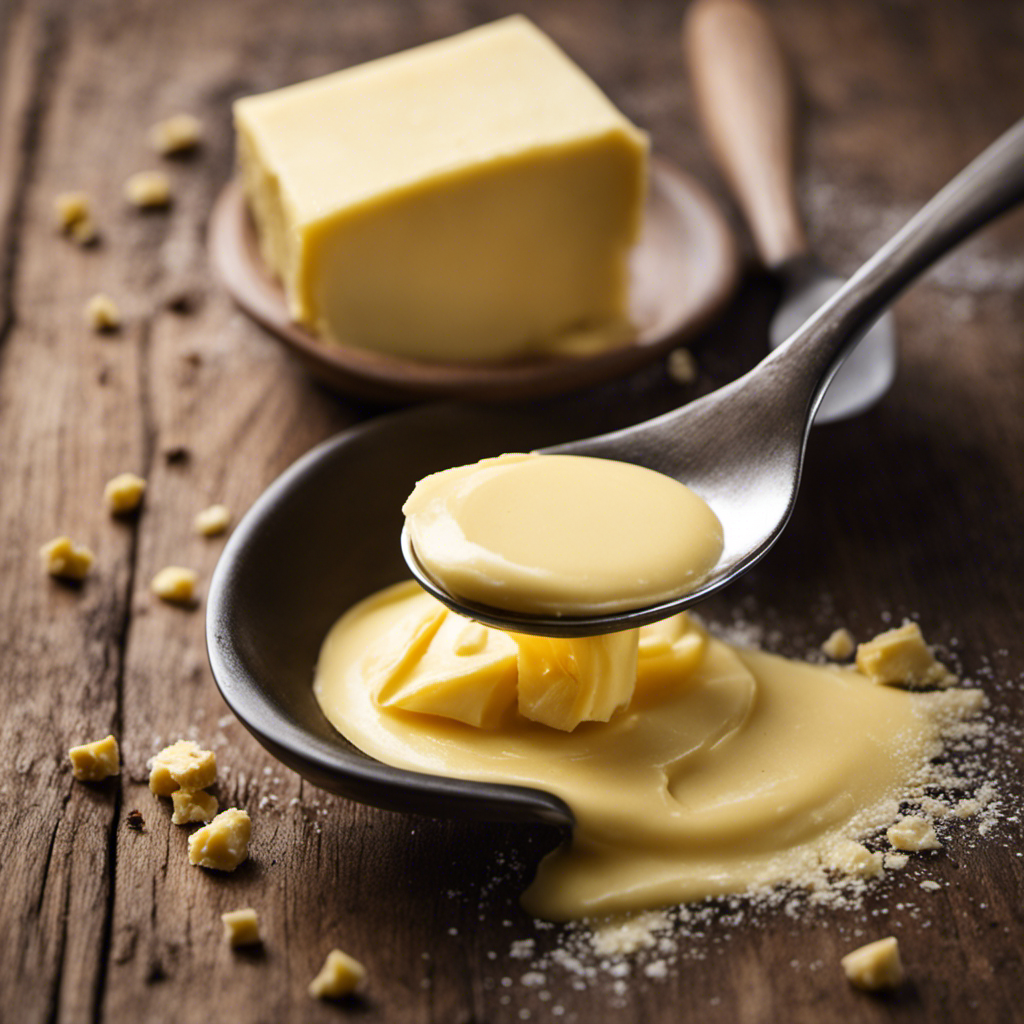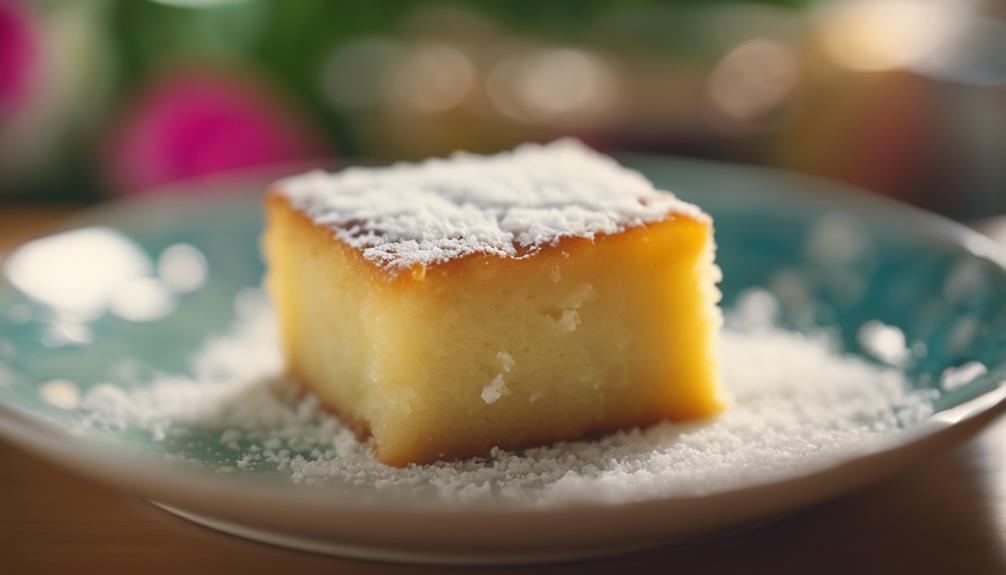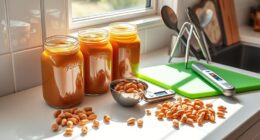I understand your skepticism about recreating Papa John’s famous garlic butter sauce at home. However, rest assured it is simpler than you may believe.
With just a few simple ingredients and some easy steps, you’ll have that delicious, garlicky goodness right in your own kitchen.
So, put away the takeout menu and get ready to impress your taste buds with this homemade version of Papa John’s garlic butter sauce.
Key Takeaways
- Papa John’s Garlic Butter Sauce is a popular sauce used in their pizzas and breadsticks.
- Garlic butter is one of the main ingredients used to make the sauce.
- There are various flavor variations of the sauce, such as smoky chipotle and tangy lemon herb.
- Alternatives to garlic butter include lemon zest, red pepper flakes, parmesan cheese, dried herbs, and white wine.
Ingredients Needed
You’ll need just a few ingredients to make Papa John’s garlic butter sauce. The star of the show is, of course, butter. While the original recipe calls for regular butter, there are alternative butter options you can try if you prefer a different flavor.
For example, you can use unsalted butter for a milder taste or even substitute it with a vegan butter for a plant-based version. The next key ingredient is garlic, which gives the sauce its distinct and aromatic flavor. The quantity of garlic can be adjusted according to your preference. If you love the strong and intense garlic flavor, feel free to add more cloves.
On the other hand, if you prefer a milder taste, you can reduce the amount of garlic used.
Step 1: Melt the Butter
When it comes to melting butter, there are a few techniques I’ve learned over the years that can help achieve a smooth and even consistency. From using a double boiler to microwaving in short bursts, each method has its own advantages.
Additionally, for those looking for alternative options to traditional butter, there are various plant-based substitutes available that can still provide a rich and creamy texture.
Butter Melting Techniques
To ensure a smooth texture, it’s important to melt the butter slowly on low heat. This will prevent the butter from burning or browning too quickly. Here are some techniques to achieve perfectly melted butter:
-
Use a small saucepan: A smaller saucepan will allow for better control over the heat distribution.
-
Cut the butter into small pieces: Smaller pieces will melt more evenly and quickly.
-
Stir continuously: Stirring the butter will promote even melting and prevent it from sticking to the bottom of the pan.
-
Keep the heat low: Low heat will prevent the butter from overheating and browning too quickly.
-
Use a double boiler: This gentle heating method will prevent direct contact between the butter and heat source, ensuring a slow and controlled melting process.
By following these techniques, you can achieve perfectly melted butter for your recipes.
Now that we have our smooth melted butter, let’s move on to exploring some delicious flavored butter ideas.
Alternative Butter Options
Now that we’ve covered alternative butter options, let’s explore some delicious flavored butter ideas. If you’re looking for a way to enhance the taste of your dishes, flavored butters are the way to go. Not only do they add a burst of flavor, but they also provide a creamy and velvety texture that will make any meal irresistible. From savory garlic butter to sweet cinnamon butter, the possibilities are endless. Here are some mouthwatering flavored butter ideas to try:
| Flavored Butter | Ingredients | Recommended Uses |
|---|---|---|
| Garlic Butter | Butter, garlic cloves, salt | Spread on bread, melt over steamed vegetables |
| Herb Butter | Butter, fresh herbs (such as parsley, thyme, rosemary), salt | Use as a topping for grilled meats or vegetables |
| Cinnamon Butter | Butter, cinnamon, honey | Perfect for spreading on toast or pancakes |
These alternatives to plain butter will elevate your cooking and add a touch of excitement to your meals. So go ahead and experiment with different flavors to find your favorite combination. Happy buttering!
Sauce Flavor Variations
If you’re looking for a way to add a burst of flavor to your meals, try experimenting with different sauce flavor variations. Here are five delicious options that will elevate your dishes to the next level:
- Smoky Chipotle: Add a few drops of chipotle hot sauce to give your sauce a smoky and spicy kick.
- Tangy Lemon Herb: Squeeze fresh lemon juice into your sauce and add a sprinkle of chopped herbs like parsley or dill for a bright and tangy flavor.
- Sweet and Spicy Honey Mustard: Mix honey and Dijon mustard into your sauce for a perfect balance of sweet and spicy flavors.
- Zesty Garlic Parmesan: Stir in grated Parmesan cheese and minced garlic for a creamy and savory taste.
- Asian-inspired Sesame Ginger: Infuse your sauce with toasted sesame oil and grated ginger for an Asian-inspired twist.
By experimenting with different oils and ingredients, you can achieve the desired sauce consistency and create unique flavors that will tantalize your taste buds.
Now, let’s move on to step 2: adding minced garlic.
Step 2: Add Minced Garlic
When it comes to enhancing the flavor of dishes with garlic, there are a few key points to consider.
First, there are alternative garlic options such as garlic powder or garlic salt that can be used in place of fresh minced garlic.
Second, the quantity of garlic used can greatly impact the overall taste, so it’s important to determine personal preference.
Lastly, experimenting with different garlic flavor enhancers, such as roasted garlic or garlic-infused oils, can provide unique and delicious results.
Garlic Flavor Enhancement
To enhance the garlic flavor in your Papa John’s garlic butter sauce, you can add a pinch of garlic powder or a splash of garlic-infused oil. These simple additions will elevate the taste and aroma of the sauce, making it even more irresistible.
Garlic has been known for its numerous health benefits, such as boosting the immune system and reducing the risk of heart disease. It is also a staple ingredient in many cuisines around the world. From Italian pasta dishes to Indian curries, garlic adds a unique and savory flavor to countless recipes.
Its versatility makes it a must-have in any kitchen. So go ahead and give your Papa John’s garlic butter sauce a garlic flavor boost, and enjoy the incredible taste it brings to your favorite dishes.
Alternative Garlic Options
Adding a hint of garlic-infused oil or a sprinkle of garlic powder can provide an alternative way to enhance the flavor of your favorite dishes. While garlic is a popular ingredient known for its distinct taste and numerous health benefits, some people may prefer to explore other options.
Garlic-infused oil is made by heating garlic cloves in oil, allowing the oil to absorb the flavor. It can be drizzled over salads, pasta, or roasted vegetables for a subtle garlic taste.
On the other hand, garlic powder is a convenient option that can be easily sprinkled onto soups, stews, or marinades. It offers a concentrated and intense garlic flavor.
These garlic alternatives can be a great addition to your cooking repertoire, allowing you to explore different flavors while still enjoying the health benefits of garlic.
Garlic Quantity Preference?
Some people may prefer to explore other options for the quantity of garlic they use in their dishes. When it comes to garlic, there are two main options: garlic powder and fresh garlic. Each option has its own unique characteristics and benefits. Here are some factors to consider when deciding how much garlic to use:
-
Freshness: Fresh garlic provides a strong and pungent flavor that can elevate any dish. It adds a vibrant and aromatic element to your cooking.
-
Convenience: Garlic powder is a convenient option, as it is easily accessible and can be stored for longer periods. It also saves time as it eliminates the need for peeling and chopping.
-
Health benefits: Fresh garlic is known for its numerous health benefits. It contains compounds that boost the immune system, reduce inflammation, and improve heart health.
-
Intensity: Garlic powder has a more concentrated flavor compared to fresh garlic. It can be a great option if you want a milder garlic taste in your dishes.
-
Versatility: Both garlic powder and fresh garlic can be used in a variety of dishes, from soups and sauces to marinades and dressings. The choice depends on personal preference and the specific flavor profile you want to achieve.
Step 3: Saute the Garlic
After peeling and mincing the garlic cloves, I sauté them in a pan with melted butter until fragrant.
Sautéing garlic is a technique that brings out its natural flavors and adds depth to any dish. The heat from the pan releases the aromatic compounds in garlic, creating a rich and savory taste.
It’s important to keep the heat low and stir frequently to prevent the garlic from burning. The key to successful sautéing is to cook the garlic until it turns golden brown, which takes about 2-3 minutes.
Once sautéed, the garlic can be used in a variety of dishes. It pairs well with ingredients like onions, tomatoes, and herbs, enhancing the overall flavor profile.
Sautéed garlic adds a delicious and aromatic touch to pasta dishes, stir-fries, and even soups.
Step 4: Add Salt and Parsley
To enhance the flavor of your dish, sprinkle a pinch of salt and a handful of freshly chopped parsley into the sautéed garlic. The salt will bring out the natural flavors of the garlic, while the parsley will add a fresh and vibrant taste.
Here are five alternatives to garlic butter that can further enhance the flavor of your sauce:
- Lemon zest: adds a tangy and zesty flavor to the sauce.
- Red pepper flakes: gives a spicy kick to the sauce.
- Parmesan cheese: adds a rich and savory taste.
- Dried herbs (such as oregano or thyme): brings a burst of herbal flavors.
- White wine: adds depth and complexity to the sauce.
Step 5: Mix Well
Mix the ingredients together until they are well combined and form a smooth mixture. This step is crucial in creating a delicious and creamy garlic butter sauce.
To achieve the perfect consistency, I recommend using a whisk or a fork to thoroughly blend the ingredients. The time required for mixing can vary depending on the utensil you use and your desired outcome.
If you prefer a chunkier texture, mix for a shorter period of time. For a smoother consistency, continue mixing until all the ingredients are fully incorporated. The key is to ensure that the garlic, butter, salt, and parsley are evenly distributed throughout the sauce.
Once the mixture is well combined, it’s time to move on to the next step: letting it simmer.
Step 6: Let It Simmer
While it simmers, make sure to stir occasionally to prevent the sauce from sticking to the bottom of the pan.
As the garlic sauce simmers, it starts to thicken and the flavors meld together, creating a deliciously creamy and aromatic sauce.
The cooking time for the sauce can vary depending on how thick you want it to be. If you prefer a thinner consistency, simmer it for around 10 minutes. For a thicker sauce, let it simmer for about 15 minutes. The longer you simmer it, the more the flavors intensify and the sauce thickens.
The heavenly aroma of the garlic fills the air, tempting your taste buds and making your mouth water. The anticipation builds as you wait for the sauce to reach the perfect thickness.
Once the sauce is done simmering, it’s time to move on to the next step: cooling and storing.
Step 7: Cool and Store
Once it has cooled down, you can transfer the sauce into a container for storage in the refrigerator. It’s important to allow the sauce to cool completely before storing it to prevent any condensation from forming inside the container. This will help preserve the flavor and texture of the garlic butter sauce.
The cooling time may vary depending on the temperature of your kitchen, but generally, it takes about 30 minutes to an hour for the sauce to cool down. Once it’s cool, carefully pour the sauce into an airtight container and seal it tightly. Make sure to label the container with the date, so you know when it was made.
Proper storage in the refrigerator will keep the sauce fresh for up to two weeks.
Serving Suggestions
Now that you’ve learned how to cool and store Papa John’s garlic butter sauce, let’s move on to serving suggestions.
This delicious sauce can be paired with a variety of dishes to enhance their flavors. Here are some ideas to inspire you:
- Drizzle the garlic butter sauce over freshly baked breadsticks for a mouthwatering appetizer.
- Use it as a dipping sauce for crispy chicken tenders or juicy grilled shrimp.
- Add a dollop of the sauce on top of a hot slice of pizza for an extra burst of flavor.
- Toss it with cooked pasta and vegetables for a quick and tasty garlic butter pasta dish.
- Spread it on a grilled cheese sandwich for an elevated twist on a classic favorite.
The versatility of Papa John’s garlic butter sauce allows you to get creative and explore different flavor combinations.
Frequently Asked Questions
How Long Does the Garlic Butter Sauce Last When Stored in the Refrigerator?
When stored in the refrigerator, the garlic butter sauce typically lasts for about 2 weeks. To ensure its freshness, it is best to store it in an airtight container.
Can I Use Margarine Instead of Butter for This Recipe?
Sure, you can substitute margarine for butter in this recipe. However, keep in mind that the flavor might be slightly different. It’s always good to experiment with flavor alternatives to find what you like best.
Can I Use Garlic Powder Instead of Minced Garlic?
Yes, you can use garlic powder as a substitute for minced garlic in Papa John’s Garlic Butter Sauce. It will provide a similar flavor, but make sure to adjust the amount to your taste.
What Can I Use if I Don’t Have Parsley for the Sauce?
If you don’t have parsley for the sauce, you can try using other herbs like oregano, basil, or thyme to add flavor. Experiment with different combinations to find your preferred substitute.
Can I Add Any Other Herbs or Spices to Enhance the Flavor of the Garlic Butter Sauce?
Yes, you can definitely add other herbs or spices to enhance the flavor of the garlic butter sauce. There are many ways to customize it, such as adding oregano, thyme, or even a pinch of cayenne pepper for some heat. These variations of garlic butter sauce can take your dish to the next level.
Conclusion
So there you have it, my homemade version of Papa John’s garlic butter sauce!
It’s a simple and delicious sauce that adds a burst of flavor to any dish.
Did you know that Papa John’s uses over 100,000 pounds of garlic every year just for their famous garlic butter sauce?
That’s enough garlic to fill 1,000 bathtubs!
Now you can enjoy this iconic sauce in the comfort of your own home.
So go ahead, gather your ingredients and give it a try.
Your taste buds will thank you!
